

Round-robin scheduling is a technique for efficiently distributing sales leads and accelerating lead response times.
If you're a company that assigns meetings, tickets, tasks, accounts, contacts, and leads to more than one person, round-robin scheduling is a good way to do this efficiently.

Round-robin scheduling is a technique for efficiently distributing sales leads and accelerating lead response times.
If you're a company that assigns meetings, tickets, tasks, accounts, contacts, and leads to more than one person, round-robin scheduling is a good way to do this efficiently.
For step-by-step instructions on how to properly use and set up and execute a round-robin scheduling algorithm, keep reading! Whether you’re optimizing...
... this article will help you understand how to implement a round-round scheduling method.
Round Robin Scheduling is a scheduling algorithm that assigns prospects to sales or business development reps in a cyclic fashion (that's the "round" part of round robin).
For example, if you have 10 sales reps in your North America region, round-robin scheduling will assign leads to each rep in the order in which they come in. So rep A gets the first lead, rep B gets the second lead, and so on.
Or, to use a metaphor, a round robin event is a bit like dealing cards.
Say you’ve got four players. Using the round robin principle, you would deal a card to player 1, then a card to player 2, player 3, player 4, then repeat the process until the entire deck of cards has been dealt.
If you're an SDR assigning a meeting to an AE using Handoff, here's what the round-robin will look like as you're scheduling the meeting:

Using a round-robin meeting system, leads are distributed in a rotational manner where reps take turns.
Rather than manually deciding which rep gets which lead, the process is automated, giving everyone a chance to interact with promising prospects.
So what’s so great about using the round-robin scheduling algorithm?
Here are four main benefits:
First, and most importantly, it increases your speed to lead time.
The faster your sales reps respond to leads, the better their chance is of converting.
And in this day and age, you need to be lightning quick.
Respond within one minute, and the chance of converting increases by 391%.
Wait one hour, and it drops to 36%.
Wait one day, and it’s down to just 17%.
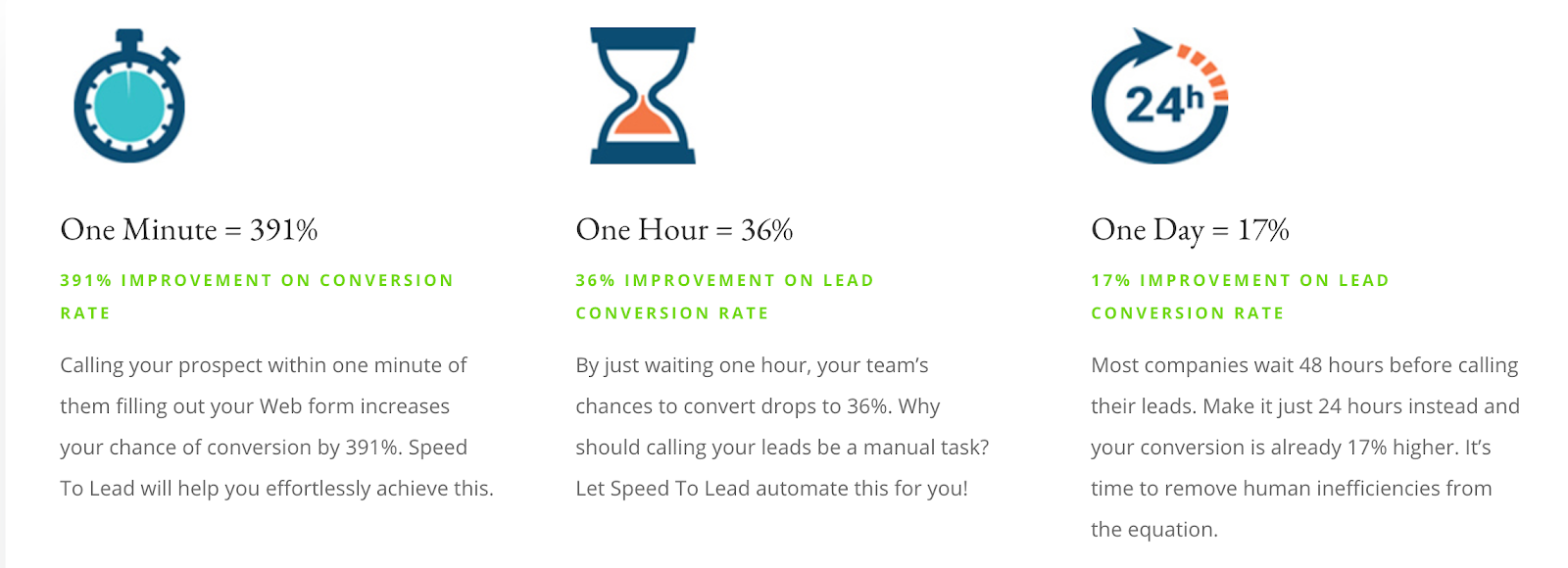
Research has also found that nearly four out of five deals go to the first vendor that responds.

So it definitely pays to have an ultra-fast sales routing system in place. And that’s exactly what round-robin scheduling offers.
For instance, with Chili Piper, inbound meeting distribution is done by cycling through a group of sales reps whenever a new meeting is booked.

Then, the prospect is routed to a sales rep so the rep can capitalize on the opportunity and have meaningful interactions when the prospect’s interest is likely at its peak.

In some cases, leads can have a real-time call right then and there if they want.

Or they can choose to schedule a time with the next sales rep in the round-robin queue at the time most convenient for them.
The bottom line is that reps can jump on leads while they’re hot and make the most of them.
Considering that 80% of companies take more than 5 minutes to respond, businesses that use round-robin processes and scheduling algorithms can gain a significant advantage over the competition.
Moreover, the round-robin algorithm is an easily implementable method that requires only basic details to be entered, such as the arrival time and burst time of each process.
Fair allocation is when all team members are getting assigned an equal share of incoming meetings.
With a round-robin scheduling process, meetings are distributed evenly across the team. Many teams accomplish this through a spreadsheet, where all the reps are listed and meetings are tallied on a month-by-month basis.
For small teams, a spreadsheet is a fine way to get started — but there are lots of inefficiencies. For example:
When you're working on a small team, a spreadsheet can usually do the trick. But once you get more than five reps — or start separating reps into teams for different industries and geographies, a spreadsheet can quickly get out of control.
When you're working with a round-robin algorithm, on the other hand, things start to get fired up, because you can optimize for equal distribution and availability at the same time. Nice! 🔥
This means that you can give your prospect the first available time slot — improving speed to lead and speeding up the sales cycle — while also making sure reps are given equal priority to incoming meetings.
Chili Piper automatically counts the number of meetings each rep receives and makes sure those numbers are even across the team.
As long as the time quantum is chosen accurately, the algorithm can be used to optimize for availability.

TL, DR: If your primary goal is to give everyone an equal opportunity and level the lead distribution playing field, the round round meeting system is a great way to go about it.
If a prospect is scheduled to meet with a rep with they're OOO... that's a pretty awkward situation.
Option 1 is insisting all your reps stay in the office, all the time. No vacations ever.
Option 2 is making your prospects wait until you’re reps are back from vacation (awk)
Option 3 is using a tool like Chili Piper that accounts for rep vacation time. So your customers can always meet with a rep, and your reps can freely take vacation.
We recommend option 3. 😉
Here’s how this would play out in a real-world scenario:
Let’s say a rep is out of office for the afternoon and unable to take meetings after 2pm.
Or maybe they’re on vacation for the week and can’t take any meetings at all.
In situations like these, it’s helpful to pause lead routing so reps don’t get leads on jobs they can’t handle.
This ensures there are no disruptions to meetings and leads aren’t left hanging.
With Chili Piper, you can pause lead routing.
For times that reps aren’t available for meetings, they can reserve specific blocks directly into their calendar. No sweat.
Here’s an example:
A rep can use vacation rules for a round robin event on Chili Piper where they modify their regular working hours by enabling Vacation Calibration.
Let’s say this is what their normal working hours look like:

If they need to pause incoming leads, they can simply click the box for “Enable Vacation Calibration.”

When Vacation Calibration is enabled, it says “OFF” beside the rep’s name in the Round Robin History.
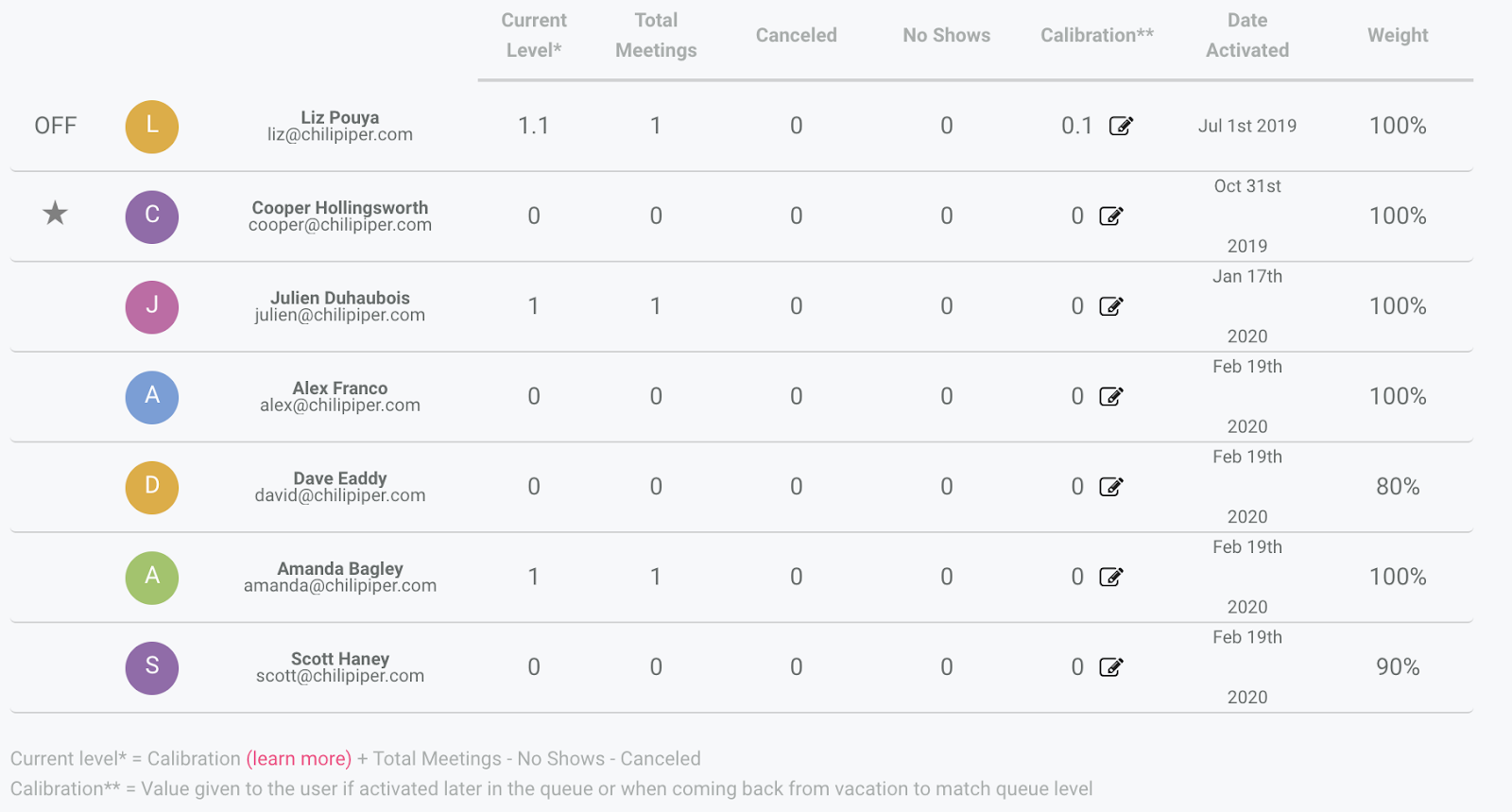
Mic drop. 🎤 💥
At this point, you know what round robin scheduling is, you know there's something called a "round robin algorithm", and you know that you can set up a round robin event type in Chili Piper.
But how does this all fit together?
First, some definitions.
Great question, thanks for asking.
A round-robin algorithm can optimize for both equal distribution and availability. This means ensuring your team members are given equal priority for meetings while ensuring your customers can book the earliest available time.
Although the concept is easy — everyone takes turns — there are a lot of variables that require configuration.
Thankfully, with tools like Chili Piper that automate the process, it’s not complicated to do so.
Here are the basic steps to follow when getting set up.
The first step is to configure routing rules based on the specific rules within your company.
For example, you can set it up so the platform will credit back an assignee if a lead is a no-show or a meeting is canceled.
You can also allow a re-assignment for events.
Or, you can assign different weights for each assignee based on their experience level and other factors.

Also, note that there’s a “flexible round robin,” where a user can skip the suggested rep and select other users to book a meeting instead.

And there’s “strict round robin,” where a user can’t select other users, and they can only select the next user in the queue to book a meeting.
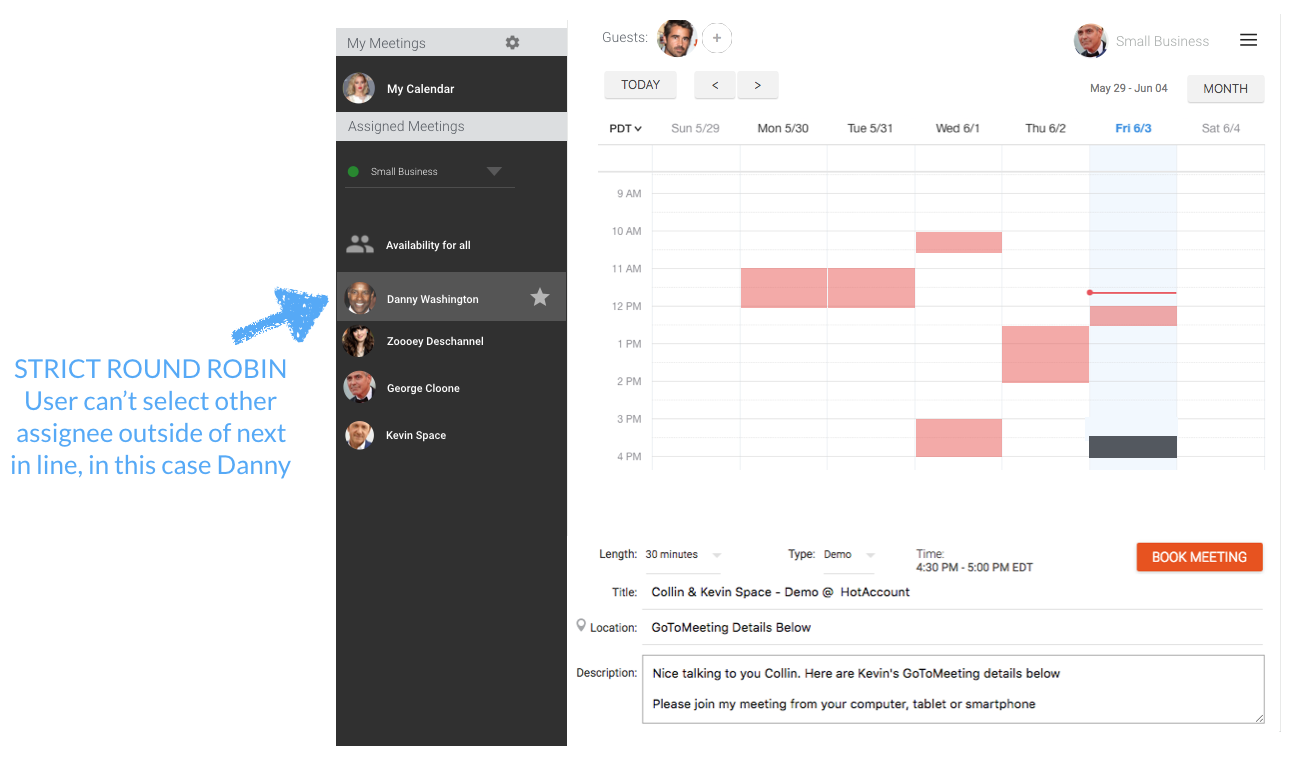
This allows for plenty of customization so you can distribute leads based on your own unique preferences.
You can get more details on how the round-robin algorithm works for Chili Piper and how to configure routing rules in this guide.
Let's say you have a round-robin queue for your North American Enterprise team members — Mary, Joe, and Stacy. But you also have a round-robin queue for your Canada - Enterprise team members — Mary, Joe, and Mike.
How do you make sure distribution is fair across the two teams?
With Chili Piper, you can combine your round-robin counter across queues. This makes sure that you optimize for equal distribution across your entire team of reps — regardless of whether they're included in multiple round-robin queues.

Meetings booked within Chili Piper within a round-robin are "counted" for a period of time (this period of time is configured in your admin settings). By default, the round-robin resets itself every month.
A team member receiving a meeting is called an Assignee in Chili Piper. A team member booking a meeting is called a Booker.
By default, the app suggests — with a star — the team member with the fewest number of meetings for the time period.
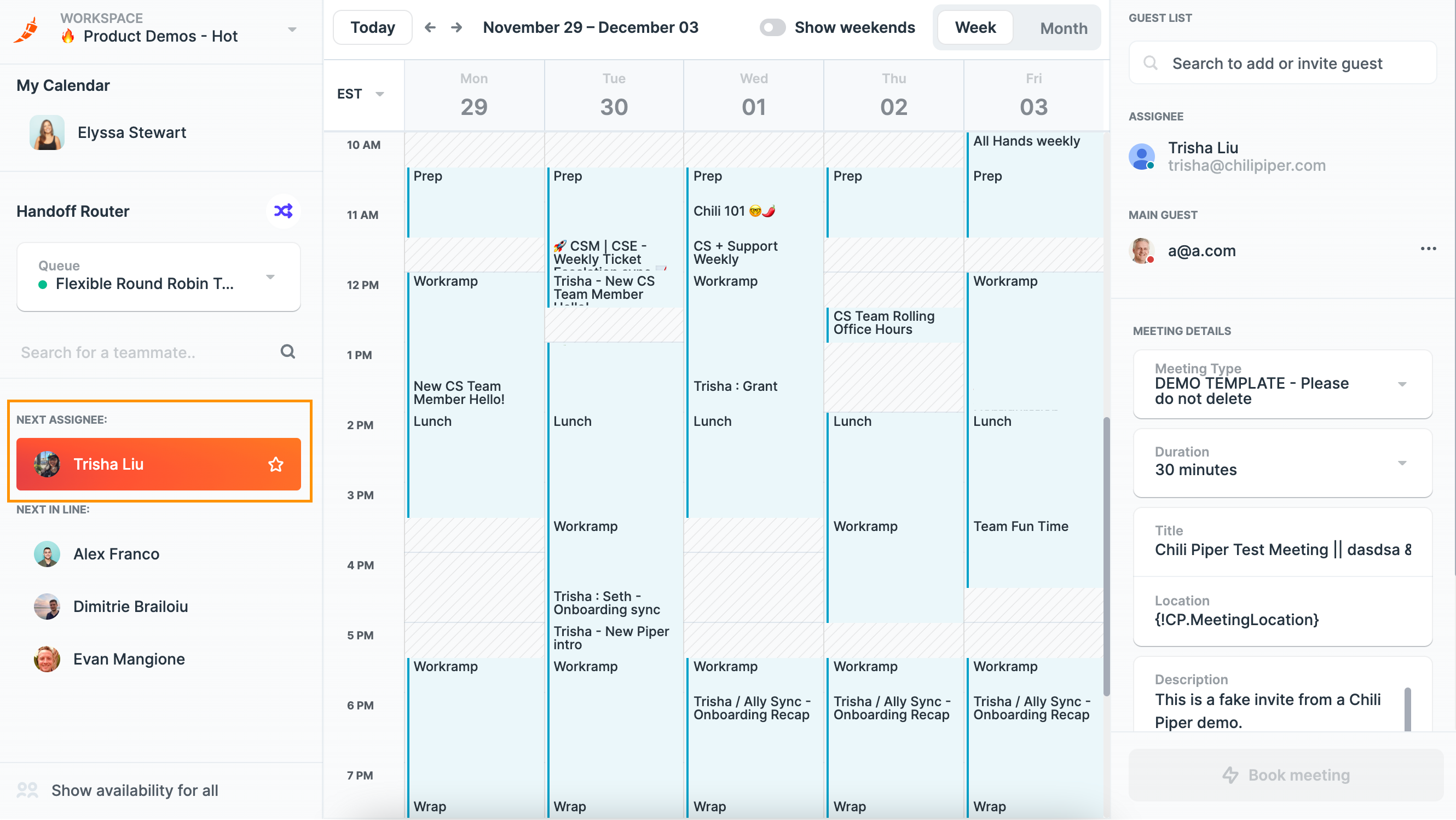
If the next assignee is not available to take the meeting, you can click on Availability for All.
Then, the round-robin algorithm will provide availability for all reps, so your prospect can choose the time slot that works best for them.
You can choose to set up your round-robin event as:
In both cases, Availability for All can be selected and the round robin algorithm picks the team member with the fewest meetings available at the specific time limit you selected.
The benefit of a flexible round-robin event is that you can increase conversions and shorten the sales cycle. The more availability you offer a customer, the more likely they find a suitable time slot that works for them — and the sooner you close the deal!
Setting up a round-robin event type is easy. Here's how you do it:
From here, you can choose your queue types. If we're creating a round-robin event type, we'll choose "Advanced Round Robin" as our queue type.
It's worth noting that Advanced Round Robin is the most widely used algorithm type for setting up queues.

If we're creating the queue for the North America - Enterprise team, add all team members that are part of that team.
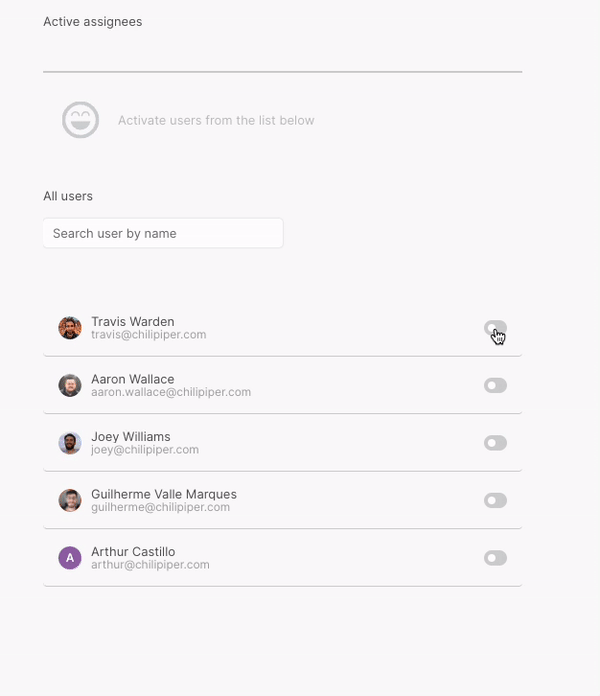
Rules allow you to specify the criteria and characteristics a prospect will need to match before booking a meeting into a queue.
Rules are made up of:
Finally, map the fields from your CRM and Forms to Chili Piper! You'll need to repeat this process if you have different forms with different fields.
And that's it! You've completed setting up your round robin event type.
For a step-by-step for how to set up your round robin event type (with screenshots and all that good stuff), check our Form Concierge Set-Up Guide.
Automating the round-robin process is a great way to optimize time slots and ensure reps all get an equal share of leads, without giving anyone special priority.
The process is based on the round-robin principle, which is a real-time algorithm that works by allowing each process to be executed for a specific period of time before it is preempted by the execution of another process.
Here's an example of how it works, using Chili Piper's team scheduling features:
Chili Piper also takes into account vacation time for your team and different weights you might want to assign to different teammates (for instance you might want fewer meetings for teammates that have just joined the team).
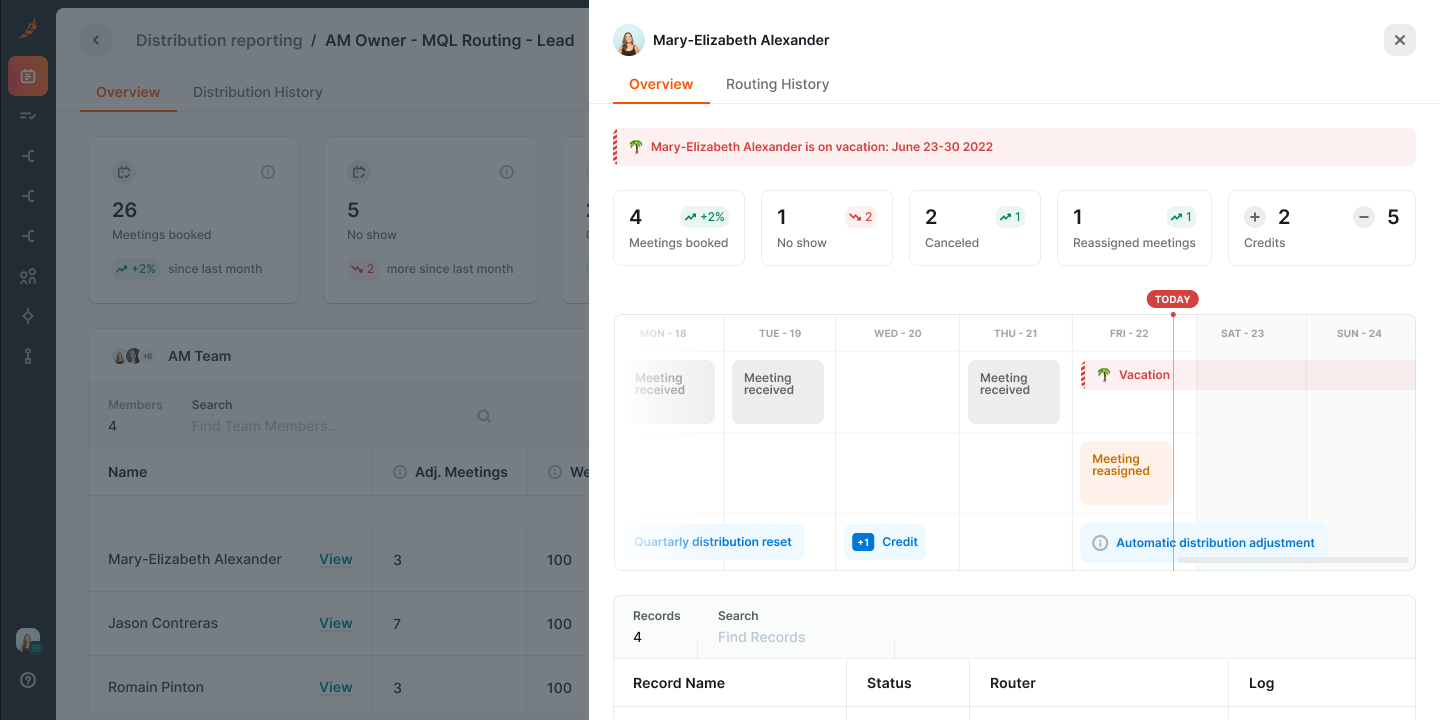
By automating the round-robin process, organizations can save time and ensure that their events are optimized for availability and equal distribution.
Through the use of pre-emptive algorithms and a context-switching method, the round-robin process ensures that no process is left behind or unfairly allocated.
In addition, the automation of this process allows for teams to create a better understanding of their capacity. See our headcount planner for customer success teams as an example.
Here are answers to some of the most frequently asked questions about round robin meetings.
Round robin scheduling is when leads are sent to reps in a rotational manner based on their position in a queue. The process is done automatically based on configured routing rules.
A round-robin scheduling algorithm ensures that all team members get an equal share of available meetings. It optimizes for both equal distribution and availability, ensuring all team members are allocated the same number of meetings and that your customers can book time with you during their first available time slot.
The main benefit of round-robin scheduling is that it improves conversions and ensures equal distribution. It's also easily implementable.
If reps are unavailable, Chili Piper pools the availability of the reps within the round robin queue (or ready queue) to cater to the customer.
If a rep is at a complete deficit of meetings, their availability will be prioritized so they are the most likely to receive a meeting.
If a rep is unavailable then Chili Piper continues to count the number of meetings in the round robin so the rep is prioritized.
This ensures fair distribution while still catering to the needs of when a customer wants to meet.
In summary, it’s no problem if a rep is out of the office, on vacation or simply too busy to handle new meetings.
While we love the simplicity that Calendly provides for scheduling, Chili Piper is designed to improve funnel conversions — from doubling inbound conversions to increasing show rates by 50%. Not only for meetings but also for lead routing, account and contacts distribution for all marketing and sales motions. 50,000+ revenue teams count on us to double their conversion rates in their funnel.
Yes! It's very easy to set up round robin scheduling. If you're using a tool like Chili Piper, some customers install in under an hour. Training and setup is included with purchase.
For step-by-step instructions on how to properly use and set up and execute a round-robin scheduling algorithm, keep reading! Whether you’re optimizing...
... this article will help you understand how to implement a round-round scheduling method.
Round Robin Scheduling is a scheduling algorithm that assigns prospects to sales or business development reps in a cyclic fashion (that's the "round" part of round robin).
For example, if you have 10 sales reps in your North America region, round-robin scheduling will assign leads to each rep in the order in which they come in. So rep A gets the first lead, rep B gets the second lead, and so on.
Or, to use a metaphor, a round robin event is a bit like dealing cards.
Say you’ve got four players. Using the round robin principle, you would deal a card to player 1, then a card to player 2, player 3, player 4, then repeat the process until the entire deck of cards has been dealt.
If you're an SDR assigning a meeting to an AE using Handoff, here's what the round-robin will look like as you're scheduling the meeting:

Using a round-robin meeting system, leads are distributed in a rotational manner where reps take turns.
Rather than manually deciding which rep gets which lead, the process is automated, giving everyone a chance to interact with promising prospects.
So what’s so great about using the round-robin scheduling algorithm?
Here are four main benefits:
First, and most importantly, it increases your speed to lead time.
The faster your sales reps respond to leads, the better their chance is of converting.
And in this day and age, you need to be lightning quick.
Respond within one minute, and the chance of converting increases by 391%.
Wait one hour, and it drops to 36%.
Wait one day, and it’s down to just 17%.

Research has also found that nearly four out of five deals go to the first vendor that responds.

So it definitely pays to have an ultra-fast sales routing system in place. And that’s exactly what round-robin scheduling offers.
For instance, with Chili Piper, inbound meeting distribution is done by cycling through a group of sales reps whenever a new meeting is booked.

Then, the prospect is routed to a sales rep so the rep can capitalize on the opportunity and have meaningful interactions when the prospect’s interest is likely at its peak.

In some cases, leads can have a real-time call right then and there if they want.

Or they can choose to schedule a time with the next sales rep in the round-robin queue at the time most convenient for them.
The bottom line is that reps can jump on leads while they’re hot and make the most of them.
Considering that 80% of companies take more than 5 minutes to respond, businesses that use round-robin processes and scheduling algorithms can gain a significant advantage over the competition.
Moreover, the round-robin algorithm is an easily implementable method that requires only basic details to be entered, such as the arrival time and burst time of each process.
Fair allocation is when all team members are getting assigned an equal share of incoming meetings.
With a round-robin scheduling process, meetings are distributed evenly across the team. Many teams accomplish this through a spreadsheet, where all the reps are listed and meetings are tallied on a month-by-month basis.
For small teams, a spreadsheet is a fine way to get started — but there are lots of inefficiencies. For example:
When you're working on a small team, a spreadsheet can usually do the trick. But once you get more than five reps — or start separating reps into teams for different industries and geographies, a spreadsheet can quickly get out of control.
When you're working with a round-robin algorithm, on the other hand, things start to get fired up, because you can optimize for equal distribution and availability at the same time. Nice! 🔥
This means that you can give your prospect the first available time slot — improving speed to lead and speeding up the sales cycle — while also making sure reps are given equal priority to incoming meetings.
Chili Piper automatically counts the number of meetings each rep receives and makes sure those numbers are even across the team.
As long as the time quantum is chosen accurately, the algorithm can be used to optimize for availability.

TL, DR: If your primary goal is to give everyone an equal opportunity and level the lead distribution playing field, the round round meeting system is a great way to go about it.
If a prospect is scheduled to meet with a rep with they're OOO... that's a pretty awkward situation.
Option 1 is insisting all your reps stay in the office, all the time. No vacations ever.
Option 2 is making your prospects wait until you’re reps are back from vacation (awk)
Option 3 is using a tool like Chili Piper that accounts for rep vacation time. So your customers can always meet with a rep, and your reps can freely take vacation.
We recommend option 3. 😉
Here’s how this would play out in a real-world scenario:
Let’s say a rep is out of office for the afternoon and unable to take meetings after 2pm.
Or maybe they’re on vacation for the week and can’t take any meetings at all.
In situations like these, it’s helpful to pause lead routing so reps don’t get leads on jobs they can’t handle.
This ensures there are no disruptions to meetings and leads aren’t left hanging.
With Chili Piper, you can pause lead routing.
For times that reps aren’t available for meetings, they can reserve specific blocks directly into their calendar. No sweat.
Here’s an example:
A rep can use vacation rules for a round robin event on Chili Piper where they modify their regular working hours by enabling Vacation Calibration.
Let’s say this is what their normal working hours look like:

If they need to pause incoming leads, they can simply click the box for “Enable Vacation Calibration.”

When Vacation Calibration is enabled, it says “OFF” beside the rep’s name in the Round Robin History.

Mic drop. 🎤 💥
At this point, you know what round robin scheduling is, you know there's something called a "round robin algorithm", and you know that you can set up a round robin event type in Chili Piper.
But how does this all fit together?
First, some definitions.
Great question, thanks for asking.
A round-robin algorithm can optimize for both equal distribution and availability. This means ensuring your team members are given equal priority for meetings while ensuring your customers can book the earliest available time.
Although the concept is easy — everyone takes turns — there are a lot of variables that require configuration.
Thankfully, with tools like Chili Piper that automate the process, it’s not complicated to do so.
Here are the basic steps to follow when getting set up.
The first step is to configure routing rules based on the specific rules within your company.
For example, you can set it up so the platform will credit back an assignee if a lead is a no-show or a meeting is canceled.
You can also allow a re-assignment for events.
Or, you can assign different weights for each assignee based on their experience level and other factors.

Also, note that there’s a “flexible round robin,” where a user can skip the suggested rep and select other users to book a meeting instead.

And there’s “strict round robin,” where a user can’t select other users, and they can only select the next user in the queue to book a meeting.

This allows for plenty of customization so you can distribute leads based on your own unique preferences.
You can get more details on how the round-robin algorithm works for Chili Piper and how to configure routing rules in this guide.
Let's say you have a round-robin queue for your North American Enterprise team members — Mary, Joe, and Stacy. But you also have a round-robin queue for your Canada - Enterprise team members — Mary, Joe, and Mike.
How do you make sure distribution is fair across the two teams?
With Chili Piper, you can combine your round-robin counter across queues. This makes sure that you optimize for equal distribution across your entire team of reps — regardless of whether they're included in multiple round-robin queues.

Meetings booked within Chili Piper within a round-robin are "counted" for a period of time (this period of time is configured in your admin settings). By default, the round-robin resets itself every month.
A team member receiving a meeting is called an Assignee in Chili Piper. A team member booking a meeting is called a Booker.
By default, the app suggests — with a star — the team member with the fewest number of meetings for the time period.

If the next assignee is not available to take the meeting, you can click on Availability for All.
Then, the round-robin algorithm will provide availability for all reps, so your prospect can choose the time slot that works best for them.
You can choose to set up your round-robin event as:
In both cases, Availability for All can be selected and the round robin algorithm picks the team member with the fewest meetings available at the specific time limit you selected.
The benefit of a flexible round-robin event is that you can increase conversions and shorten the sales cycle. The more availability you offer a customer, the more likely they find a suitable time slot that works for them — and the sooner you close the deal!
Setting up a round-robin event type is easy. Here's how you do it:
From here, you can choose your queue types. If we're creating a round-robin event type, we'll choose "Advanced Round Robin" as our queue type.
It's worth noting that Advanced Round Robin is the most widely used algorithm type for setting up queues.

If we're creating the queue for the North America - Enterprise team, add all team members that are part of that team.

Rules allow you to specify the criteria and characteristics a prospect will need to match before booking a meeting into a queue.
Rules are made up of:
Finally, map the fields from your CRM and Forms to Chili Piper! You'll need to repeat this process if you have different forms with different fields.
And that's it! You've completed setting up your round robin event type.
For a step-by-step for how to set up your round robin event type (with screenshots and all that good stuff), check our Form Concierge Set-Up Guide.
Automating the round-robin process is a great way to optimize time slots and ensure reps all get an equal share of leads, without giving anyone special priority.
The process is based on the round-robin principle, which is a real-time algorithm that works by allowing each process to be executed for a specific period of time before it is preempted by the execution of another process.
Here's an example of how it works, using Chili Piper's team scheduling features:
Chili Piper also takes into account vacation time for your team and different weights you might want to assign to different teammates (for instance you might want fewer meetings for teammates that have just joined the team).

By automating the round-robin process, organizations can save time and ensure that their events are optimized for availability and equal distribution.
Through the use of pre-emptive algorithms and a context-switching method, the round-robin process ensures that no process is left behind or unfairly allocated.
In addition, the automation of this process allows for teams to create a better understanding of their capacity. See our headcount planner for customer success teams as an example.
Here are answers to some of the most frequently asked questions about round robin meetings.
Round robin scheduling is when leads are sent to reps in a rotational manner based on their position in a queue. The process is done automatically based on configured routing rules.
A round-robin scheduling algorithm ensures that all team members get an equal share of available meetings. It optimizes for both equal distribution and availability, ensuring all team members are allocated the same number of meetings and that your customers can book time with you during their first available time slot.
The main benefit of round-robin scheduling is that it improves conversions and ensures equal distribution. It's also easily implementable.
If reps are unavailable, Chili Piper pools the availability of the reps within the round robin queue (or ready queue) to cater to the customer.
If a rep is at a complete deficit of meetings, their availability will be prioritized so they are the most likely to receive a meeting.
If a rep is unavailable then Chili Piper continues to count the number of meetings in the round robin so the rep is prioritized.
This ensures fair distribution while still catering to the needs of when a customer wants to meet.
In summary, it’s no problem if a rep is out of the office, on vacation or simply too busy to handle new meetings.
While we love the simplicity that Calendly provides for scheduling, Chili Piper is designed to improve funnel conversions — from doubling inbound conversions to increasing show rates by 50%. Not only for meetings but also for lead routing, account and contacts distribution for all marketing and sales motions. 50,000+ revenue teams count on us to double their conversion rates in their funnel.
Yes! It's very easy to set up round robin scheduling. If you're using a tool like Chili Piper, some customers install in under an hour. Training and setup is included with purchase.
